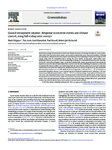Coastal embayment rotation: Response to extreme events and climate control, using full embayment surveys
| dc.contributor.author | Wiggins, Mark | |
| dc.contributor.author | Scott, Tim | |
| dc.contributor.author | Masselink, Gerd | |
| dc.contributor.author | Russell, Paul | |
| dc.contributor.author | McCarroll, Jak | |
| dc.date.accessioned | 2019-01-21T12:07:23Z | |
| dc.date.available | 2019-01-21T12:07:23Z | |
| dc.date.issued | 2019-02-15 | |
| dc.identifier.issn | 0169-555X | |
| dc.identifier.issn | 1872-695X | |
| dc.identifier.uri | http://hdl.handle.net/10026.1/13182 | |
| dc.description.abstract |
© 2018 The Authors Barrier beach change in directionally bi-modal wave climates presents an increasing challenge for coastal communities, both in the short-term (storm events), and decadal to centurial time scales (long-term evolution). Predicting and planning for subsequent variations requires understanding of the morphological response to changes in wave energy, along with the atmospheric forces driving the wave climate. In this paper, multi-method topo-bathymetric surveys are used to assess the morphological change of a semi-sheltered gravel barrier (Start Bay, Devon, UK). Total sediment budgets (supra- to sub-tidal), with spatially-varying uncertainty levels, indicate the embayment is closed. One third of total sediment flux occurred in the sub-tidal, establishing the importance of sub-tidal transport for this type of coastline. Our results demonstrate that under the predominance of a given wave direction, rotation first occurs within sub-embayments. Additional sustained and extreme energy levels are then required for full embayment rotation to occur, with significant headland bypassing. In this instance, 6 × 105 m3 of gravel was transported alongshore during a 3-year sustained period of dominant-southerly waves, including a 1:50 year storm season (full-embayment rotation), whilst 3 × 105 m3 was returned during a 2-year period of dominant easterly waves (sub-embayment rotation only). A novel parameter is introduced that predicts beach rotation based on the directional wave balance. In turn, winter wave direction is shown to correlate with a combination of two climate indices. Given adequate predictions of relevant climate indices, these findings constitute the basis of a generalisable method to predict and plan for future beach rotation on similar beaches globally. | |
| dc.format.extent | 385-403 | |
| dc.language | en | |
| dc.language.iso | en | |
| dc.publisher | Elsevier | |
| dc.subject | Storm response | |
| dc.subject | Beach morphodynamics | |
| dc.subject | Sediment budget | |
| dc.subject | Headland bypassing | |
| dc.subject | Beach rotation | |
| dc.title | Coastal embayment rotation: Response to extreme events and climate control, using full embayment surveys | |
| dc.type | journal-article | |
| dc.type | Journal Article | |
| plymouth.author-url | https://www.webofscience.com/api/gateway?GWVersion=2&SrcApp=PARTNER_APP&SrcAuth=LinksAMR&KeyUT=WOS:000456491600027&DestLinkType=FullRecord&DestApp=ALL_WOS&UsrCustomerID=11bb513d99f797142bcfeffcc58ea008 | |
| plymouth.volume | 327 | |
| plymouth.publication-status | Published | |
| plymouth.journal | Geomorphology | |
| dc.identifier.doi | 10.1016/j.geomorph.2018.11.014 | |
| plymouth.organisational-group | /Plymouth | |
| plymouth.organisational-group | /Plymouth/Admin Group - REF | |
| plymouth.organisational-group | /Plymouth/Admin Group - REF/REF Admin Group - FoSE | |
| plymouth.organisational-group | /Plymouth/Faculty of Science and Engineering | |
| plymouth.organisational-group | /Plymouth/Faculty of Science and Engineering/School of Biological and Marine Sciences | |
| plymouth.organisational-group | /Plymouth/REF 2021 Researchers by UoA | |
| plymouth.organisational-group | /Plymouth/REF 2021 Researchers by UoA/UoA07 Earth Systems and Environmental Sciences | |
| plymouth.organisational-group | /Plymouth/Research Groups | |
| plymouth.organisational-group | /Plymouth/Research Groups/Marine Institute | |
| plymouth.organisational-group | /Plymouth/Users by role | |
| plymouth.organisational-group | /Plymouth/Users by role/Academics | |
| plymouth.organisational-group | /Plymouth/Users by role/Researchers in ResearchFish submission | |
| dcterms.dateAccepted | 2018-11-13 | |
| dc.rights.embargodate | 2019-1-26 | |
| dc.identifier.eissn | 1872-695X | |
| dc.rights.embargoperiod | Not known | |
| rioxxterms.versionofrecord | 10.1016/j.geomorph.2018.11.014 | |
| rioxxterms.licenseref.uri | http://www.rioxx.net/licenses/all-rights-reserved | |
| rioxxterms.licenseref.startdate | 2019-02-15 | |
| rioxxterms.type | Journal Article/Review | |
| plymouth.funder | Physical and biological dynamic coastal processes and their role in coastal recovery (BLUE-coast)::NERC | |
| plymouth.funder | Physical and biological dynamic coastal processes and their role in coastal recovery (BLUE-coast)::NERC |


